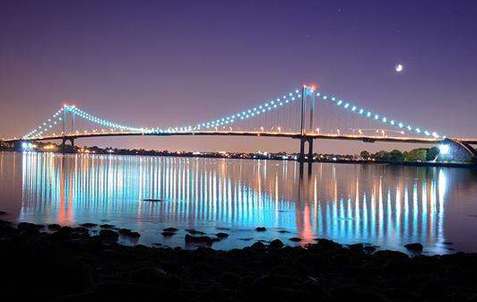
Bronx–Whitestone Bridge
USINFO | 2013-05-09 17:15

The Bronx–Whitestone Bridge (colloquially referred to as the Whitestone Bridge or simply the Whitestone) is a suspension bridge in New York City that crosses the East River and connects the boroughs of Queens on Long Island and The Bronx via Interstate 678. The bridge was designed by Othmar Ammann and opened to traffic with four lanes on April 29, 1939.
The idea for a crossing between the Bronx and Whitestone, Queens had come as early as 1905. At the time, residents around the proposed area of the bridge protested construction in fear of losing the then-rural character of the area.
In 1929, however, the Regional Plan Association had proposed another bridge from the Bronx to northern Queens to allow motorists from upstate New York and New England to reach Queens and Long Island without traveling through the traffic-ridden communities of western Queens.[3] On February 25, 1930, influential planner Robert Moses proposed a Ferry Point Park-Whitestone Bridge as a part of his Belt Parkway system around Brooklyn and Queens.
As the 1930s progressed, Moses found his bridge increasingly necessary to directly link the mainland to the 1939 New York World's Fair and to LaGuardia Airport (then known as North Beach Airport). In addition, the Whitestone Bridge was to provide congestion relief to the Triborough Bridge.
The New York Legislature approved Moses' plan in April 1937. Moses had raised controversy when he quickly decided to demolish seventeen homes in the Queens community of Malba. Moses argued such measures were necessary to complete the bridge on schedule.
The RPA had also said that the Whitestone Bridge should have rail connections, or at least be able to accommodate them in the future, but had no allies on the project, to Moses' relief.
The bridge carries two local / limited-stop bus routes, the Q44, operated by MTA New York City Transit, and the Q50, operated by the MTA Bus Company (formerly known as the QBx1).
After the removal of the sidewalks starting in 1943, bicyclists were able to use QBx1 buses of the Queens Surface Corporation, which could carry bicycles on the front-mounted bike racks. However, since the Metropolitan Transportation Authority absorbed the bus routes formerly operated by Queens Surface, the bike racks have been eliminated.[7] Bicyclists are now forced to detour to the Triborough Bridge or possibly try hitchhiking across, which is illegal[8] and considered very dangerous. Whether a bikeway or walkway will be constructed on the bridge in the future is uncertain.
The Bronx–Whitestone Bridge assists I-678 in crossing the East River. From the Queens side, the Whitestone Expressway carries I-678 to the bridgehead. The Cross Island Parkway meets up with the Whitestone Expressway 1/2 mile before the bridge.
On the Bronx side, the bridge leads directly into the Bruckner Interchange, which serves as the northern terminus of I-678, which is where the Cross Bronx Expressway (I-95), Bruckner Expressway (I-278 & I-95), Hutchinson River Parkway, and the Cross Bronx Expressway extension (I-295) meet. The segment of I-678 between the bridge and the Bruckner Interchange is a depressed freeway.
The idea for a crossing between the Bronx and Whitestone, Queens had come as early as 1905. At the time, residents around the proposed area of the bridge protested construction in fear of losing the then-rural character of the area.
In 1929, however, the Regional Plan Association had proposed another bridge from the Bronx to northern Queens to allow motorists from upstate New York and New England to reach Queens and Long Island without traveling through the traffic-ridden communities of western Queens.[3] On February 25, 1930, influential planner Robert Moses proposed a Ferry Point Park-Whitestone Bridge as a part of his Belt Parkway system around Brooklyn and Queens.
As the 1930s progressed, Moses found his bridge increasingly necessary to directly link the mainland to the 1939 New York World's Fair and to LaGuardia Airport (then known as North Beach Airport). In addition, the Whitestone Bridge was to provide congestion relief to the Triborough Bridge.
The New York Legislature approved Moses' plan in April 1937. Moses had raised controversy when he quickly decided to demolish seventeen homes in the Queens community of Malba. Moses argued such measures were necessary to complete the bridge on schedule.
The RPA had also said that the Whitestone Bridge should have rail connections, or at least be able to accommodate them in the future, but had no allies on the project, to Moses' relief.
The bridge carries two local / limited-stop bus routes, the Q44, operated by MTA New York City Transit, and the Q50, operated by the MTA Bus Company (formerly known as the QBx1).
After the removal of the sidewalks starting in 1943, bicyclists were able to use QBx1 buses of the Queens Surface Corporation, which could carry bicycles on the front-mounted bike racks. However, since the Metropolitan Transportation Authority absorbed the bus routes formerly operated by Queens Surface, the bike racks have been eliminated.[7] Bicyclists are now forced to detour to the Triborough Bridge or possibly try hitchhiking across, which is illegal[8] and considered very dangerous. Whether a bikeway or walkway will be constructed on the bridge in the future is uncertain.
The Bronx–Whitestone Bridge assists I-678 in crossing the East River. From the Queens side, the Whitestone Expressway carries I-678 to the bridgehead. The Cross Island Parkway meets up with the Whitestone Expressway 1/2 mile before the bridge.
On the Bronx side, the bridge leads directly into the Bruckner Interchange, which serves as the northern terminus of I-678, which is where the Cross Bronx Expressway (I-95), Bruckner Expressway (I-278 & I-95), Hutchinson River Parkway, and the Cross Bronx Expressway extension (I-295) meet. The segment of I-678 between the bridge and the Bruckner Interchange is a depressed freeway.
Share this page



















